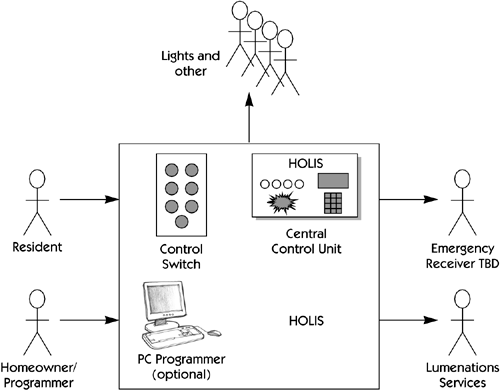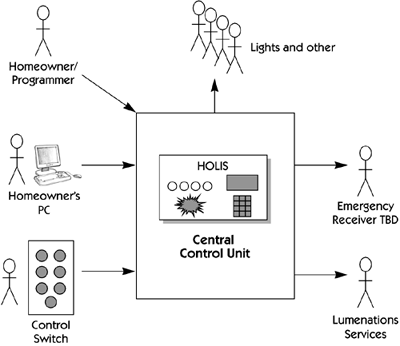Lumenations Problem Statement In analyzing the problem, the team discovered that there are actually three different groups of stakeholders, each of whom sees the problem differently. Thus the team decided to develop three problem statements, the first of which seemed to state the obvious problem from the company's perspective (Table A-1). Table A-1. Problem Statement for Lumenations | Element | Description | | The problem of . . . | Slowing growth in the company's core professional theater marketplaces . | | Affects . . . | The company, its employees , and its shareholders. | | And results in . . . | Unacceptable business performance and lack of substantive opportunities for growth in revenue and profitability. | | Benefits of a solution . . . | Involving new products and a potential new marketplace for the company's products and services include -
Revitalization of the company and its employees -
Increased loyalty and retention of the company's distributors -
Higher revenue growth and profitability -
Upturn in the company's stock price | Next, the team also decided to see whether it could understand the "problem" from the perspectives of a future customer (end user ) and potential distributors/builders (Lumenations' customers). The team developed the problem statements shown in Tables A-2 and A-3, respectively. Table A-2. Problem Statement for the Homeowner | Element | Description | | The problem of . . . | The lack of product choices, limited functionality, and the high cost of existing home lighting automation systems. | | Affects . . . | The homeowners of high-end residential systems. | | And results in . . . | Unacceptable performance of the purchased systems or, more often than not, a decision not to automate. | | Benefits of a solution . . . | That comprised the "right" lighting automation solution could include -
Higher homeowner satisfaction and pride of ownership -
Increased flexibility and usability of the residence -
Improved safety, comfort , and convenience | Table A-3. Problem Statement for the Distributor | Element | Description | | The problem of . . . | The lack of product choices, limited functionality, and the high cost of existing home lighting automation systems. | | Affects . . . | The distributors and builders of high-end residential systems. | | And results in . . . | Few opportunities for marketplace differentiation and no new opportunities for higher-margin products. | | Benefits of a solution . . . | That comprised the "right" lighting automation solution could include | System Block Diagram with Actors Identified Figure A-2 identifies the actors in this case study. Figures A-3, A-4, and A-5 show the subsystem block diagrams. Figure A-2. HOLIS with subsystems and actors  Figure A-3. Control Switch subsystem with actors  Figure A-4. PC Programmer subsystem with actors  Figure A-5. Central Control Unit subsystem with actors  Actor Survey A number of actors will interact with HOLIS (Table A-4). Table A-4. Actors for HOLIS | Actor | Comments | | Lights and other | Output devices, lights and dimmer controls, others to be determined | | Homeowner/ Programmer | Homeowner programs direct to Central Control Unit or through programmer PC | | Emergency Receiver | Unknown; under investigation | | Resident | Homeowner using Control Switch to change lighting | | Lumenations Services | Lumenations employees supporting remote programming and maintenance activities | Stakeholder Survey HOLIS has a number of nonactor stakeholders, both external and internal (Table A-5). Table A-5. Nonactor Stakeholders for HOLIS | Stakeholder | Comments | | External Distributors | Lumenations' direct customer | | Builders | Lumenations' customer's customer: the general contractor responsible to the homeowner for the end result | | Electrical contractors | Responsible for installation and support | | Internal Development team | Lumenations' team | | Marketing/product management | Will be represented by Alyssa, product manager | | Lumenations' general management | Funding and outcome accountability | Constraints Imposed on the Solution Over a period of 45 days at the beginning of the product development effort, the HOLIS development team and Lumenations management identified, discussed, and agreed on the constraints listed in Table A-6. Table A-6. Constraints for the HOLIS project | ID # | Description | Rationale | | 1 | Version 1.0 will be released to manufacturing by January 5. | This is the only product launch opportunity this year. | | 2 | The team will adopt UML modeling, OO-based methodologies, and the Unified Software Development Process. | We believe these technologies will provide increased productivity and more robust systems. | | 3 | The software for the Central Control Unit and PC Programmer will be written in Java. Assembly language will be used for the Control Switch. | These choices provide consistency and maintainability; also, the team knows these languages. | | 4 | A prototype system must be displayed at the December Home Automation trade show. | We want to take distributors' orders for the first quarter of the fiscal year. | | 5 | The microprocessor subsystem for the Central Control Unit will be copied from the professional division's advanced lighting system project (ALSP). | We can use an existing design and an inventoried part. | | 6 | The only PC Programmer configuration supported will be compatible with Windows 2000 and Windows XP. | This way we can better manage the scope for release 1.0. | | 7 | The team will be allowed to hire two new full-time employees, after a successful inception phase, with whatever skill set is determined to be necessary. | The maximum allowable budget expansion limits us to two new hires. | | 8 | The KCH5444 single-chip microprocessor will be used in the Control Switch. | The company already uses this microprocessor. | | 9 | Purchased software components will be permitted as long as there is no continuing royalty obligation to the company. | We want to avoid any long- term cost of goods sold impact for software. | |



